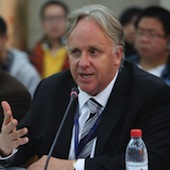After TPP: RCEP as China’s Magic Bullet?
China will not lead free trade in Asia, contrary to many forecasts.
February 17, 2017
With America’s retreat from the TPP, many commentators have argued that China will take over the lead of trade liberalization in Asia.
The primary assumed mechanism would be through the Regional Comprehensive Economic Partnership (RCEP), another mega trade deal currently being negotiated.
Nothing could be further from the truth!
The RCEP is a negotiation that seeks to create one single FTA between the ten ASEAN member states (Brunei Darussalam, Cambodia, Indonesia, Lao PDR, Malaysia, Myanmar, Philippines, Singapore, Thailand, Viet Nam) and those six countries that already have FTAs with ASEAN – Australia, China, India, Japan, Republic of Korea and New Zealand — the “Plus-6 countries”.
The RCEP were launched in November 2012, with the goal of completing the deal by end 2015.
Paper deal, paper tiger
On paper, the RCEP looks like a huge deal. It involves half the world’s population. The participating countries account for 30% of global GDP and about a quarter of world exports and foreign investment. It could thus become the world’s biggest trading bloc.
1. After TPP: RCEP as China’s Magic Bullet?
2. Japan and Trump Trade Policy
3. America First: From TPP to TTP (=Trump Trade Policy)
4. China and Trump Trade Policy
The RCEP promises to rationalize into one agreement the complex “noodle bowl” of agreements between ASEAN and the Plus-6 countries, and result in “significant improvements” over the existing agreements.
The RCEP will also require agreements between those Plus-6 countries that don’t already have agreements.
But the RCEP is proving much more difficult than envisaged. Rationalizing into one agreement the complex “noodle bowl” of agreements between ASEAN and the Plus-6 countries is, in fact, very challenging.
Many of these agreements are quite different from each other, having been negotiated at different points in time.
Filling in the gaps between the Plus-6 agreements is also proving arduous, especially in light of the need for FTAs between China and India, China and Japan, and Korea and Japan – countries that have testy relations.
Too little, too late, if ever
The reality is that the RCEP negotiation may never be concluded. And if it is, it will not result in any significant market opening.
Its main focus is on merchandise trade barriers, rather than issues like services, investment, intellectual property and competition policy, which are key to global value chains.
In fact, apart from Singapore and Hong Kong, Asian economies have never been thrilled about open markets for trade and investment. They are mainly concerned with serving the interests of their entrenched business elites.
This is a great pity, as Asia desperately needs much more open markets to continue its development.
In the media, the RCEP is billed as a China-led negotiation, which excludes the United States, and which seeks to rival the U.S.-led TPP, even though officially it is an ASEAN-led deal.
No TPP alternative
From all reports, the RCEP negotiations are suffering from a lack of strong leadership. Some countries like India and Indonesia are not enthusiastic at all about RCEP, and China shows no visible signs of wishing to further open its markets.
The negotiating deadline of end-2015 was initially extended to 2016, and now there is the mere hope that it will be finalized in 2017. Perhaps the best indicator of the value of the RCEP is that U.S. business is not interested in it at all.
Now that the TPP is dead in the water, some RCEP countries like Australia are investing much greater energy and enthusiasm in the RCEP.
While this is welcome, it will not likely be enough to result in significant market opening under the RCEP.
